3 Fundamental Concepts in Engineering – Basic Quantities and Newton’s Laws
Let us start off with a brief review of certain fundamental concepts and principles.
In this course it is assumed that you have completed a basic physics class in your secondary school. If you need more information, I recommend that you refer to two open source textbooks. OpenStax College Physics is an algebra-based book. https://openstax.org/details/books/college-physics OpenStax University Physics is a calculus-based textbook. https://openstax.org/details/books/university-physics-volume-1 I will be using some examples and images from them in this book but I encourage you to look them over before and maybe during this course.
Basic Quantities
The following four quantities are used when we talk about mechanics. They are often called “base units” as other units can be made by combining the base units.
Length. Length is used to locate the position of a point in space. It describes the size of a certain physical system. Once you have length, you can have area and volume.
Time. Time is the indefinite continued progress of existence and events that occur in an apparently irreversible succession from the past, through the present, into the future.
Mass. Mass is a measure of the quantity of matter. It is defined by its inertia, its resistance to being accelerated, and by the gravitational attractions that occurs between two bodies.
Force. Forces are considered to be pushes or pulls exerted by one body on another body. It can occur due to direct contact when two bodies touch or there can be action at a distance such as the gravitational, magnetic and electric forces. Forces are vectors and is characterized by its magnitude, direction and the point where it is applied.
Models or Idealizations
Models, or idealizations, are used in science in order to simplify applications of theories. Here are three main idealizations we will use in this textbooks. There is an aphorism, often attributed to George Box a statistician that goes “all models are wrong, but some are useful.”
Particle. A particle has a mass, but the size can be neglected. This often depends on the system. As we stand on the Earth we are aware that is it not a particle. Yet when we consider the Earth orbiting around the Sun we treat it as a particle because with a radius of 6378 km and the semi-major axis of the orbit being 149,596,000 km the means that the Earth’s radius is only 0.004% of the orbital distance so it is reasonable to consider it a particle when we deal with orbits. We reduce things to particles to simplify the analysis as the geometry of the object will not be involved in the analysis.
Rigid Body: A rigid body can be considered to be a combination of a large number of particles where all the particles remain at the same distance from each other, even when a large force or load is applied to the body. The shape does not change. In most cases the actual deformations that occur when a body is forced is relatively small.
Concentrated Force. A concentrated force is the effect of a load which is assumed to act at point on a rigid body. We can represent the total load by a concentrated force provided the area over which the load is applied is very small compared to the overall size of the body. Think of a wheel in contact with the ground.
Newton’s Three Laws of Motion
These laws are valid for non-accelerating reference frames. First formulated in Philosophiæ Naturalis Principia Mathematica, often referred to as just The Principia. it was first published in July of 1687 and is considered one of the most important works in the history of science. These laws have been experimentally verified for many hundreds of years. While Einstein’s laws modify these laws at extreme masses and speed, the study of engineering mechanics deals with Newton’s Laws.
First law
Often called the law of inertia. A body at rest remains at rest, or, if in motion, remains in motion at a constant velocity unless acted on by a net external force. The property of a body to remain at rest or to remain in motion with constant velocity is called inertia. We say that a body is in equilibrium when the net force acting on it is zero.
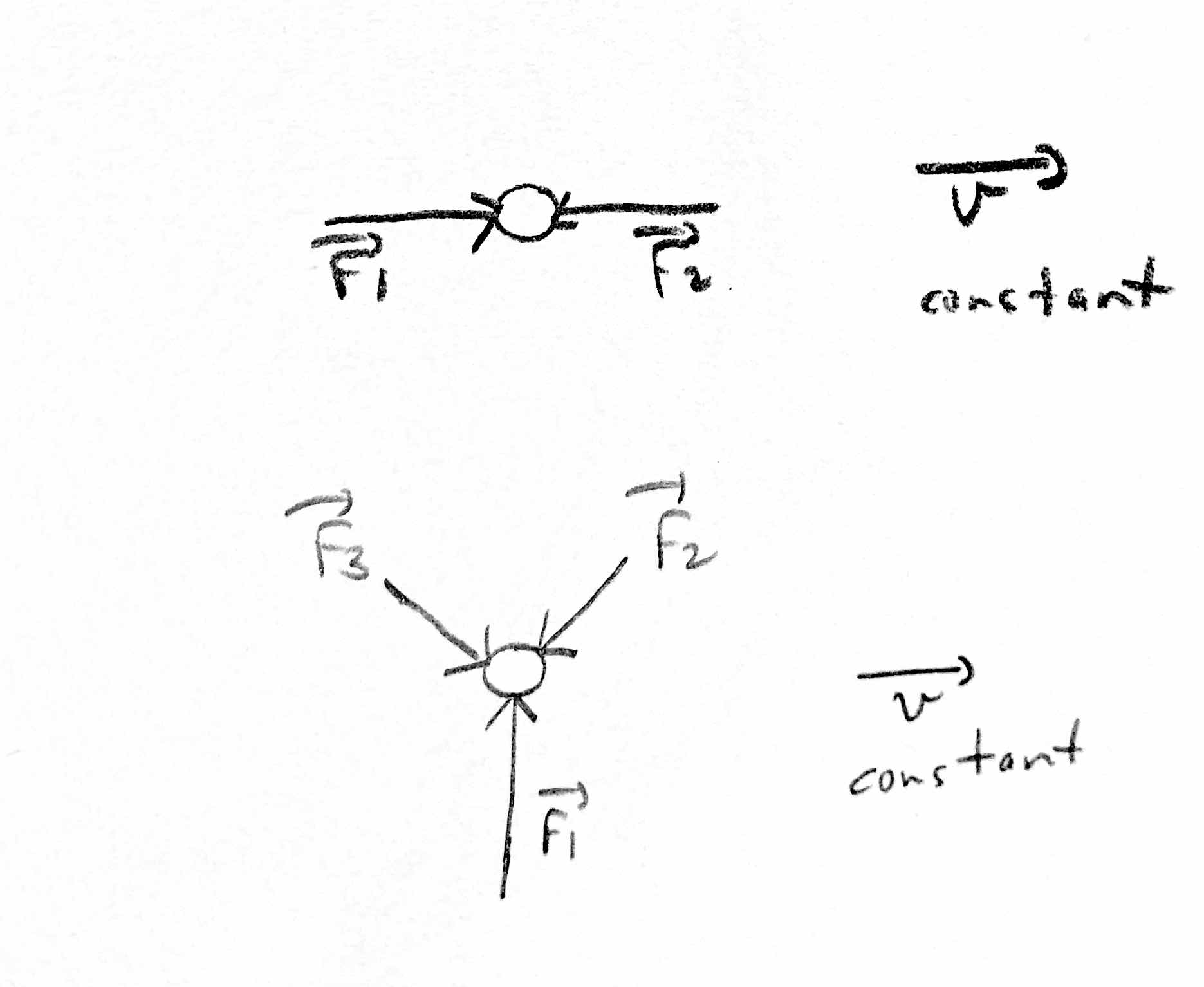
Second Law
Newton’s second law of motion is closely related to Newton’s first law of motion. It mathematically states the cause and effect relationship between force and changes in motion. Newton’s second law of motion is more quantitative and is used extensively to calculate what happens in situations involving a force. First, what do we mean by a change in motion? The answer is that a change in motion is equivalent to a change in velocity. A change in velocity means, by definition, that there is an acceleration. Newton’s first law says that a net external force causes a change in motion; thus, we see that a net external force causes acceleration. You must define the boundaries of the system before you can determine which forces are external. Sometimes the system is obvious, whereas other times identifying the boundaries of a system is more subtle. The concept of a system is fundamental to many areas of physics, as is the correct application of Newton’s laws.
To obtain an equation for Newton’s second law, we first write the relationship of acceleration and net external force as the proportionality
where the symbol
In equation form, Newton’s second law of motion is
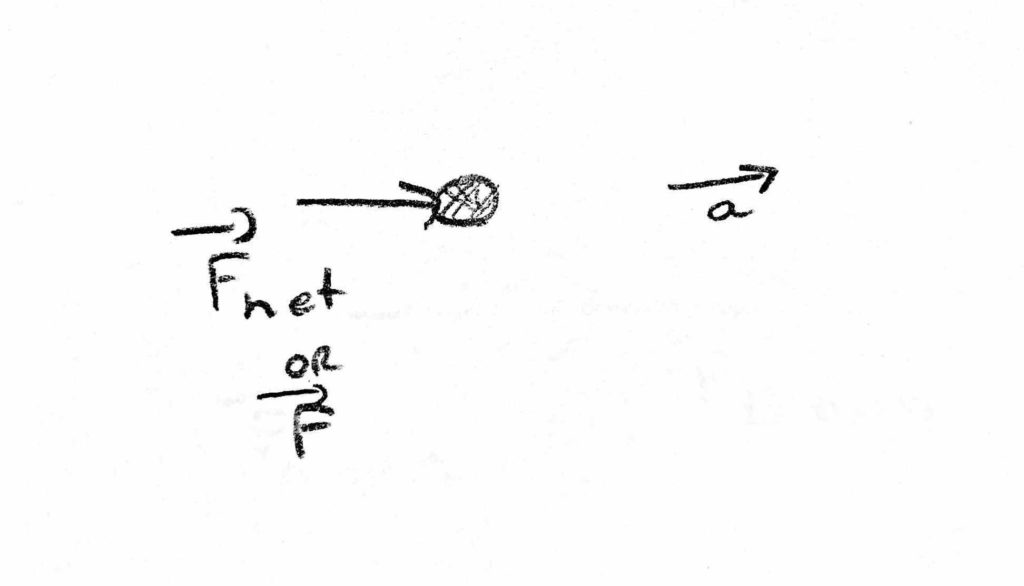
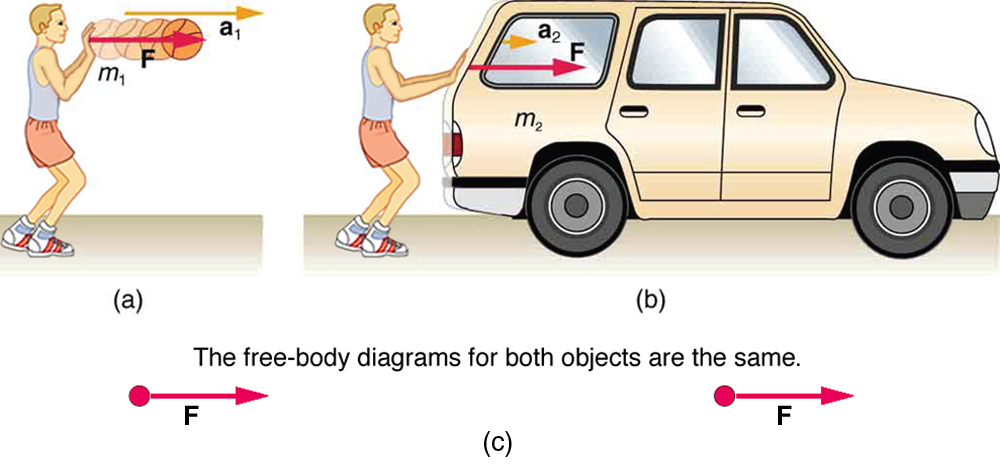
Third Law
Whenever one body exerts a force on a second body, the first body experiences a force that is equal in magnitude and opposite in direction to the force that it exerts.
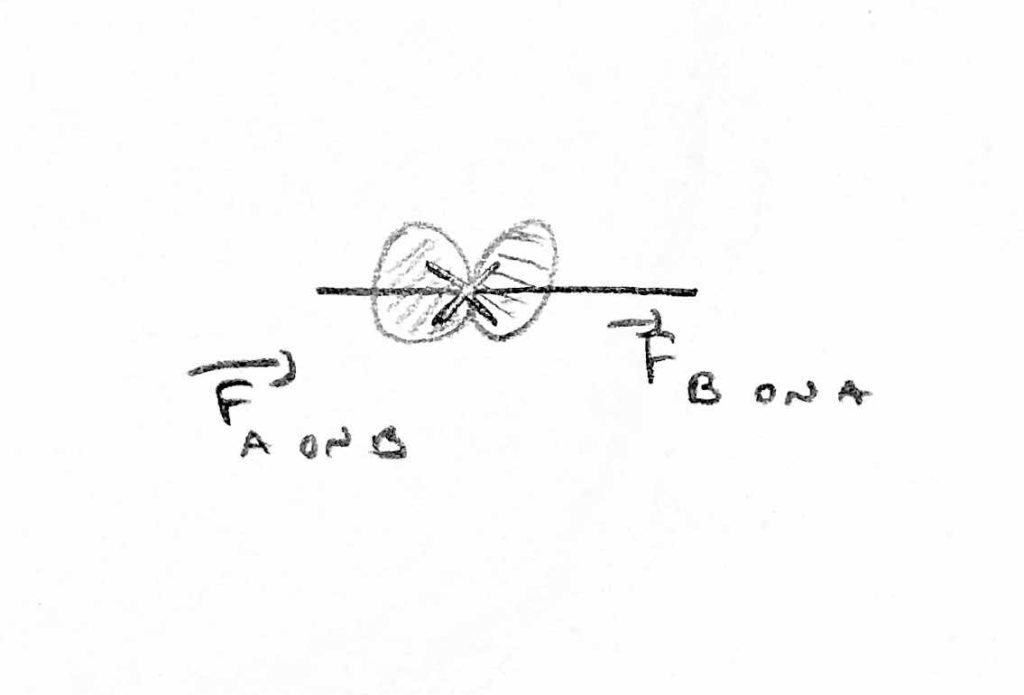
We can readily see Newton’s third law at work by taking a look at how people move about. Consider a swimmer pushing off from the side of a pool, as illustrated in the figure below. She pushes against the pool wall with her feet and accelerates in the direction opposite to that of her push. The wall has exerted an equal and opposite force back on the swimmer. You might think that two equal and opposite forces would cancel, but they do not because they act on different systems. In this case, there are two systems that we could investigate: the swimmer or the wall. If we select the swimmer to be the system of interest, as in the figure, then Fwall on feet is an external force on this system and affects its motion. The swimmer moves in the direction of Fwall on feet. In contrast, the force Ffeet on wall acts on the wall and not on our system of interest. Thus Ffeet on wall does not directly affect the motion of the system and does not cancel Fwall on feet. Note that the swimmer pushes in the direction opposite to that in which she wishes to move. The reaction to her push is thus in the desired direction.
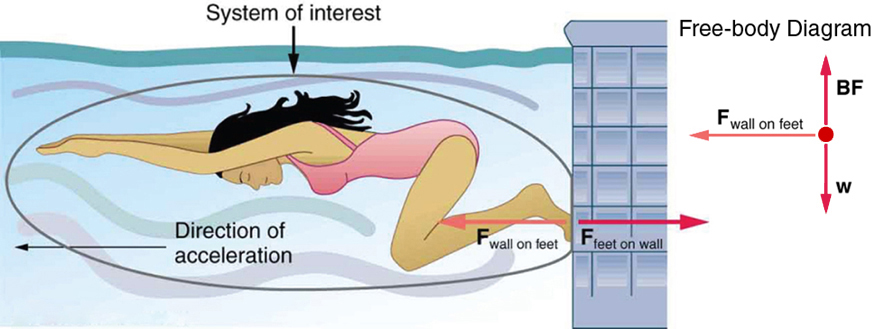
Newton’s Law of Gravitational Attraction
After he had formulated his three laws of motion, Newton began to think about gravity. His law states that each mass reaches out through space and attracts (forces toward) every other mass to itself. In equation form
where
F = force of gravitation between the two particles
G = universal constant of gravitation. Using the SI or Metric system G = 66.73(10-12) m3/(kg ·s2). It was measured experimentally for the first time in 1798 by Henry Cavendish.
m1, m2 = the masses of the two particles
r = distance between the two particles.
Weight and the Gravitational Force
When an object is dropped, it accelerates toward the centre of Earth. Newton’s second law states that a net force on an object is responsible for its acceleration. If air resistance is negligible, the net force on a falling object is the gravitational force, commonly called its weight W. Weight can be denoted as a vector
If you take m2 = MEarth = 5.972 x 1024 kg, and r = distance between a particle on the surface of the Earth and the centre of the Earth = 6378 km = 6.378 Mm at the equator, then letting
W = m g
When the net external force on an object is its weight, we say that it is in free-fall. That is, the only force acting on the object is the force of gravity. In the real world, when objects fall downward toward Earth, they are never truly in free-fall because there is always some upward force from the air acting on the object.
The acceleration due to gravity g varies slightly over the surface of Earth, so that the weight of an object depends on location and is not an intrinsic property of the object. The equatorial radius of the Earth is 6378 km while the polar radius is 6357 km. The International Bureau of Weights and Measures has a standard value for g adopted in 1901 that is based on sea level and at a latitude of 45 degrees equal to 9.80665 m/s2.
The broadest definition of weight in this sense is that the weight of an object is the gravitational force on it from the nearest large body, such as Earth, the Moon, the Sun, and so on. This is the most common and useful definition of weight in physics. It differs dramatically, however, from the definition of weight used by NASA and the popular media in relation to space travel and exploration. When they speak of “weightlessness” and “microgravity,” they are really referring to the phenomenon we call “free-fall” in physics. We shall use the above definition of weight, and we will make careful distinctions between free-fall and actual weightlessness.
It is important to be aware that weight and mass are very different physical quantities, although they are closely related. Mass is the quantity of matter (how much “stuff”) and does not vary in classical physics, whereas weight is the gravitational force and does vary depending on gravity. It is tempting to equate the two, since most of our examples take place on Earth, where the weight of an object only varies a little with the location of the object. Furthermore, the terms mass and weight are used interchangeably in everyday language; for example, our medical records often show our “weight” in kilograms, but never in the correct units of newtons.
COMMON MISCONCEPTIONS: MASS VS. WEIGHT
Mass and weight are often used interchangeably in everyday language. However, in science, these terms are distinctly different from one another. Mass is a measure of how much matter is in an object. The typical measure of mass is the kilogram (or the “slug” in English units). Weight, on the other hand, is a measure of the force of gravity acting on an object. Weight is equal to the mass of an object (m) multiplied by the acceleration due to gravity (g). Like any other force, weight is measured in terms of newtons (or pounds in English units).
Assuming the mass of an object is kept intact, it will remain the same, regardless of its location. However, because weight depends on the acceleration due to gravity, the weight of an object can change when the object enters into a region with stronger or weaker gravity. For example, the acceleration due to gravity on the Moon is 1.67 m/s2 (which is much less than the acceleration due to gravity on Earth, 9.80 m/s2). If you measured your weight on Earth and then measured your weight on the Moon, you would find that you “weigh” much less, even though you do not look any skinnier. This is because the force of gravity is weaker on the Moon. In fact, when people say that they are “losing weight,” they really mean that they are losing “mass” (which in turn causes them to weigh less).
Review of Vectors and Scalars from OpenStax College Physics
The direction of a vector in one-dimensional motion is given simply by a plus (+) or minus (−) sign. Vectors are represented graphically by arrows. An arrow used to represent a vector has a length proportional to the vector’s magnitude (e.g., the larger the magnitude, the longer the length of the vector) and points in the same direction as the vector.
Some physical quantities, like distance, either have no direction or none is specified. A scalar is any quantity that has a magnitude, but no direction. For example, a 20 °C temperature, the 250 kilocalories (250 Calories) of energy in a candy bar, a 90 km/h speed limit, a person’s 1.8 m height, and a distance of 2.0 m are all scalars—quantities with no specified direction. Note, however, that a scalar can be negative, such as a -20 °C temperature. In this case, the minus sign indicates a point on a scale rather than a direction. Scalars are never represented by arrows.
Coordinate Systems for One-Dimensional Motion
In order to describe the direction of a vector quantity, you must designate a coordinate system within the reference frame. For one-dimensional motion, this is a simple coordinate system consisting of a one-dimensional coordinate line. In general, when describing horizontal motion, motion to the right is usually considered positive, and motion to the left is considered negative. With vertical motion, motion up is usually positive and motion down is negative. In some cases, however, it can be more convenient to switch the positive and negative directions. For example, if you are analyzing the motion of falling objects, it can be useful to define downwards as the positive direction. If people in a race are running to the left, it is useful to define left as the positive direction. It does not matter as long as the system is clear and consistent. Once you assign a positive direction and start solving a problem, you cannot change it.
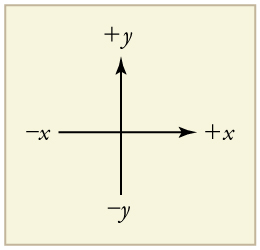
Check Your Understanding
1: A person’s speed can stay the same as he or she rounds a corner and changes direction. Given this information, is speed a scalar or a vector quantity? Explain.
Section Summary
- A vector is any quantity that has magnitude and direction.
- A scalar is any quantity that has magnitude but no direction.
- Displacement and velocity are vectors, whereas distance and speed are scalars.
- In one-dimensional motion, direction is specified by a plus or minus sign to signify left or right, up or down, and the like.
Conceptual Questions
1: A student writes, “A bird that is diving for prey has a speed of -10 m/s.” What is wrong with the student’s statement? What has the student actually described? Explain.
2: What is the speed of the bird in the question above where it is stated “A bird that is diving for prey has a speed of -10 m/s.”
3: Acceleration is the change in velocity over time. Given this information, is acceleration a vector or a scalar quantity? Explain.
4: A weather forecast states that the temperature is predicted to be -5 °C the following day. Is this temperature a vector or a scalar quantity? Explain.
Solutions
Check Your Understanding
- Speed is a scalar quantity. It does not change at all with direction changes; therefore, it has magnitude only. If it were a vector quantity, it would change as direction changes (even if its magnitude remained constant).
Conceptual Questions
- Speed is a scalar so it is correct to say “speed of 10 m/s”. The student has described the velocity vector as they gave both magnitude (speed of 10 m/s) and direction of “-“.
- Speed is a scalar so it is correct to say “speed of 10 m/s”.
- Acceleration is a vector as velocity is a vector.
- Scalar. Scalars can be negative as well as positive.

